#Prince Charles/Napoleon VI
Text

Mark Schneider, In the role of the Grand Empreor. In 2012.
Here meeting Charles Napoleon Bonaparte, also known as Prince Napoleon VI, father of Prince Jean-Christoph, Napoleon VII.
#mark schneider#reenacting#napoleon bonaparte#education#napoleonic era#being napoleon#beauty#Prince Charles/Napoleon VI#Napoleon VI#Charles Bonaparte
5 notes
·
View notes
Text
With two days left to submit nominees, here is where the list stands:
France:
Jean Lannes
Josephine de Beauharnais
Thérésa Tallien
Jean-Andoche Junot
Joseph Fouché
Charles Maurice de Talleyrand
Joachim Murat
Michel Ney
Jean-Baptiste Bernadotte (Charles XIV of Sweden)
Louis-Francois Lejeune
Pierre Jacques Étienne Cambrinne
Napoleon I
Marshal Louis-Gabriel Suchet
Jacques de Trobriand
Jean de dieu soult.
François-Étienne-Christophe Kellermann
Louis Davout
Pauline Bonaparte, Duchess of Guastalla
Eugène de Beauharnais
Jean-Baptiste Bessières
Antoine-Jean Gros
Jérôme Bonaparte
Andrea Masséna
Antoine Charles Louis de Lasalle
Germaine de Staël
Thomas-Alexandre Dumas
René de Traviere (The Purple Mask)
Claude Victor Perrin
Laurent de Gouvion Saint-Cyr
François Joseph Lefebvre
Major Andre Cotard (Hornblower Series)
Edouard Mortier
Hippolyte Charles
Nicolas Charles Oudinot
Emmanuel de Grouchy
Pierre-Charles Villeneuve
Géraud Duroc
Georges Pontmercy (Les Mis)
Auguste Frédéric Louis Viesse de Marmont
Juliette Récamier
Bon-Adrien Jeannot de Moncey
Louis-Alexandre Berthier
Étienne Jacques-Joseph-Alexandre Macdonald
Jean-Mathieu-Philibert Sérurier
Catherine Dominique de Pérignon
England:
Richard Sharpe (The Sharpe Series)
Tom Pullings (Master and Commander)
Arthur Wellesley, 1st Duke of Wellington
Jonathan Strange (Jonathan Strange & Mr. Norrell)
Captain Jack Aubrey (Aubrey/Maturin books)
Horatio Hornblower (the Hornblower Books)
William Laurence (The Temeraire Series)
Henry Paget, 1st Marquess of Anglesey
Beau Brummell
Emma, Lady Hamilton
Benjamin Bathurst
Horatio Nelson
Admiral Edward Pellew
Sir Philip Bowes Vere Broke
Sidney Smith
Percy Smythe, 6th Viscount Strangford
George IV
Capt. Anthony Trumbull (The Pride and the Passion)
Barbara Childe (An Infamous Army)
Doctor Maturin (Aubrey/Maturin books)
Scotland:
Thomas Cochrane
Colquhoun Grant
Austria:
Klemens von Metternich
Friedrich Bianchi, Duke of Casalanza
Franz I/II
Archduke Karl
Marie Louise
Franz Grillparzer
Wilhelmine von Biron
Poland:
Wincenty Krasiński
Józef Antoni Poniatowski
Józef Zajączek
Maria Walewska
Władysław Franciszek Jabłonowski
Adam Jerzy Czartoryski
Antoni Amilkar Kosiński
Zofia Czartoryska-Zamoyska
Stanislaw Kurcyusz
Russia:
Alexander I Pavlovich
Alexander Andreevich Durov
Prince Andrei (War and Peace)
Pyotr Bagration
Mikhail Miloradovich
Levin August von Bennigsen
Pavel Stroganov
Empress Elizabeth Alexeievna
Karl Wilhelm von Toll
Dmitri Kuruta
Alexander Alexeevich Tuchkov
Barclay de Tolly
Fyodor Grigorevich Gogel
Ekaterina Pavlovna Bagration
Prussia:
Louise von Mecklenburg-Strelitz
Gebard von Blücher
Carl von Clausewitz
Frederick William III
Gerhard von Scharnhorst
Louis Ferdinand of Prussia
Friederike of Mecklenburg-Strelitz
Alexander von Humboldt
Dorothea von Biron
The Netherlands:
Ida St Elme
Wiliam, Prince of Orange
The Papal States:
Pius VII
Portugal:
João Severiano Maciel da Costa
Spain:
Juan Martín Díez
José de Palafox
Inês Bilbatua (Goya's Ghosts)
Haiti:
Alexandre Pétion
Sardinia:
Vittorio Emanuele I
Denmark:
Frederik VI
Sweden:
Gustav IV Adolph
11 notes
·
View notes
Text
Events 5.12 (before 1900)
254 – Pope Stephen I succeeds Pope Lucius I, becoming the 23rd pope of the Catholic Church, and immediately takes a stand against Novatianism.
907 – Zhu Wen forces Emperor Ai into abdicating, ending the Tang dynasty after nearly three hundred years of rule.
1191 – Richard I of England marries Berengaria of Navarre in Cyprus; she is crowned Queen consort of England the same day.
1328 – Antipope Nicholas V, a claimant to the papacy, is consecrated in Rome by the Bishop of Venice.
1364 – Jagiellonian University, the oldest university in Poland, is founded in Kraków.
1497 – Pope Alexander VI excommunicates Girolamo Savonarola.
1510 – The Prince of Anhua rebellion begins when Zhu Zhifan kills all the officials invited to a banquet and declares his intent on ousting the powerful Ming dynasty eunuch Liu Jin during the reign of the Zhengde Emperor.
1551 – National University of San Marcos, the oldest university in the Americas, is founded in Lima, Peru.
1588 – French Wars of Religion: Henry III of France flees Paris after Henry I, Duke of Guise, enters the city and a spontaneous uprising occurs.
1593 – London playwright Thomas Kyd is arrested and tortured by the Privy Council for libel.
1601–1900
1743 – Maria Theresa of Austria is crowned Queen of Bohemia after defeating her rival, Charles VII, Holy Roman Emperor.
1778 – Heinrich XI, count of the Principality of Reuss-Greiz, is elevated to Prince by Joseph II, Holy Roman Emperor.
1780 – American Revolutionary War: In the largest defeat of the Continental Army, Charleston, South Carolina is taken by British forces.
1797 – War of the First Coalition: Napoleon Bonaparte conquers Venice.
1808 – Finnish War: Swedish-Finnish troops, led by Captain Karl Wilhelm Malmi, conquer the city of Kuopio from Russians after the Battle of Kuopio.
1821 – The first major battle of the Greek War of Independence against the Turks is fought in Valtetsi.
1846 – The Donner Party of pioneers departs Independence, Missouri for California, on what will become a year-long journey of hardship and cannibalism.
1862 – American Civil War: Union Army troops occupy Baton Rouge, Louisiana.
1863 – American Civil War: Battle of Raymond: Two divisions of James B. McPherson's XVII Corps turn the left wing of Confederate General John C. Pemberton's defensive line on Fourteen Mile Creek, opening up the interior of Mississippi to the Union Army during the Vicksburg Campaign.
1864 – American Civil War: The Battle of Spotsylvania Court House: Union troops assault a Confederate salient known as the "Mule Shoe", with some of the fiercest fighting of the war, much of it hand-to-hand combat, occurring at "the Bloody Angle" on the northwest.
1865 – American Civil War: The Battle of Palmito Ranch: The first day of the last major land action to take place during the Civil War, resulting in a Confederate victory.
1870 – The Manitoba Act is given the Royal Assent, paving the way for Manitoba to become a province of Canada on July 15.
1881 – In North Africa, Tunisia becomes a French protectorate.
1885 – North-West Rebellion: The four-day Battle of Batoche, pitting rebel Métis against the Canadian government, comes to an end with a decisive rebel defeat.
1888 – In Southeast Asia, the North Borneo Chartered Company's territories become the British protectorate of North Borneo.
0 notes
Text
January 07

[1528] Jeanne d'Albret, Queen of Navarre (1555-72), mother of French King Henry IV.
[1768] Joseph Bonaparte, French King of Naples and Spain, brother of Napoleon, born in Corte, Corsica.
[1796] Charlotte Augusta of Wales, British Princess and only legitimate grandchild of King George III, born in London.
[1845] Ludwig III, last King of Bavaria (1913-18), born in Munich, Bavaria.
[1926] Joe Marston, Australian football defender, born in Leichhardt, New South Wales, Australia.
[1929] Mario Bergamaschi, Italian football midfielder, born in Crema, Italy.
[1939] Prince Michael of Greece and Denmark, born in Rome, Kingdom of Italy.
[1964] Nicolas Cage, American actor, born in Long Beach, California.
[1970] João Ricardo, Angolan football goalkeeper, born in Luanda, Angola.
[1971] Jeremy Renner, American actor, born in Modesto, California.
[1977] Dustin Diamond, American actor and stand-up comedian, born in San Jose, California.
[1982] Lauren Cohan, British-American actress, born in Cherry Hill, New Jersey.
[1983] Brett Dalton, American actor, born in San Jose, California.
[1986] Grant Leadbitter, English football midfielder, born in Chester-le-Street, United Kingdom.
[1987] Davide Astori, Italian football central defender, born in San Giovanni Bianco, Italy.
[1989] Emiliano Insúa, Argentine football left-back, born in Buenos Aires, Argentina.
[1991] Eden Hazard, Belgian football winger or attacking midfielder, born in La Louvière, Belgium.
[2012] Blue Ivy Carter, American daughter of Beyoncé and Jay-Z, born in New York City, New York.

[312] Lucian of Antioch, theologist and martyr, dies from torture and starvation at 72.
[1285] Charles I of Anjou, King of Naples and Sicily (1266-85), brother of King Louis IX of France, dies at 58.
[1325] Denis of Portugal, King of Portugal (1279-1325), dies at 63.
[1355] Inês de Castro, Galician noblewoman, lover and posthumously-recognized wife of King Peter I of Portugal, is murdered in the orders of King Afonso IV at 29 or 30.
[1536] Catherine of Aragon, 1st wife of King Henry VIII, mother of Queen Mary 1, dies at 50.
[1695] Mary II, Queen of England, Scotland and Ireland, wife of King William III, dies of smallpox at 32 (OS=Dec. 28, 1694).
[1743] Anne Sophie von Reventlow, Queen of Denmark and Norway (1721-30), dies at 49.
[1830] Infanta Carlota Joaquina, daughter of King Charles IV of Spain and wife of King John VI of Portugal, dies at 53.
[1890] Augusta of Saxe-Weimar-Eisenach, wife of German Emperor William I, dies at 78.
[1922] Jonah Kūhiō Kalaniana'ole, Prince of the Kingdom of Hawaii, dies at 50.
[1943] Nikola Tesla, Serbian-American physicist,electrical engineer and inventor who developed alternating current and the Tesla Coil, dies at 86.
[1989] Emperor Shōwa (Hirohito), 124th Emperor of Japan (1926-89), dies at 87 after a 62-year reign.
[2020] Khamis Al-Owairan, Saudi Arabian football midfielder, dies from cancer at 46.
#on this day in history#on this day#otdih#otd#football history#football#january#january 07#birthdays#rest in peace#nicolas cage#jeremy renner#dustin diamond#lauren cohan#brett dalton#eden hazard#joseph bonaparte#blue ivy carter#beyoncé#jay z#peter i of portugal#catherine of aragon#mary ii#nikola tesla#emperor hirohito
0 notes
Photo


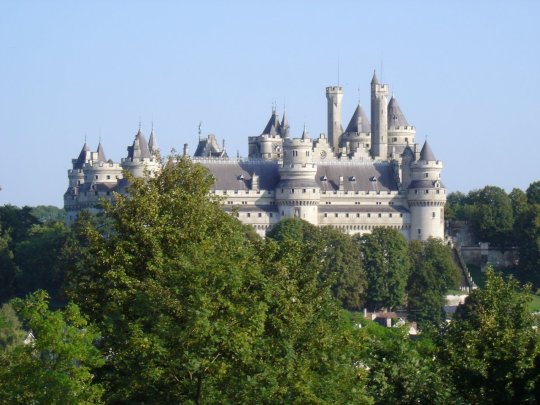
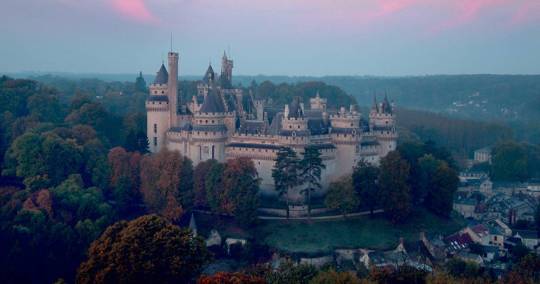

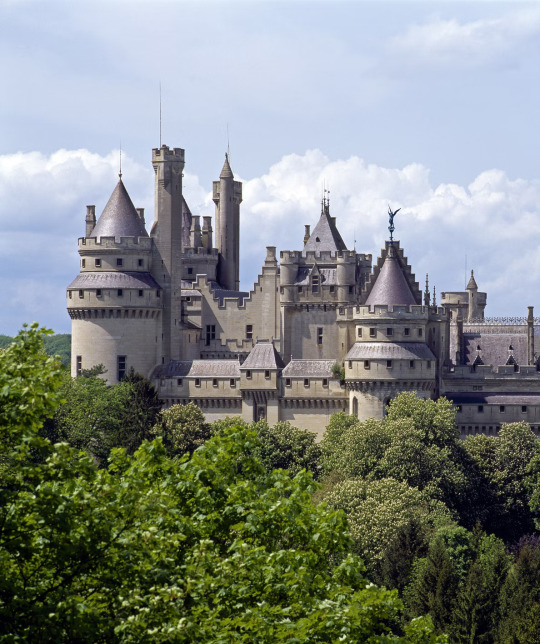

Pierrefonds Castle in France.
~ “This enormous fortress constructed in the 14th century by Louis d'Orléans, the brother of Charles VI, the Château de Pierrefonds, was besieged and then torn down by Louis XIII at the beginning of the 17th century. For almost two centuries the imposing ruins stood unattended – nearly unnoticed. It was not until the end of the 18th century and the beginning of the 19th, with the onset of Romanticism and renewed interest in national monuments and the past, that the Château de Pierrefonds became once again the centre of attention.
Painters, draughtsmen and engravers all found in the castle inspiration which matched their enthusiasm for the archaeology of France. Indeed, on the 11th August 1832, Louis-Philippe held a great banquet in honour of the marriage of his daughter to the Leopold 1st of Belgium in the midst of the castle's majestic ruins.
Sold in 1798 as a site of national interest, bought back by Napoleon I in 1810, the château was declared as a building of national historic interest in 1848. The enthusiastic archaeologist, the Prince-President Louis-Napoleon visited the site on the 15th July, 1850. Several years later, on becoming Napoleon III, Louis declared his desire to have the château restored, situated as it was so close to his imperial residence in Compiègne. Hence, Viollet-le-Duc (via the good agencies of Merimée) was chosen as the architect to oversee the restoration of the medieval ruins of Pierrefonds. Initially (1858-1861), the plan was to restore only part of the building, that is, the keep and the large towers, and to shore up the dilapidated walls, so as to leave a 'picturesque ruin'.
But in 1861 this plan was abandoned in favour of creating an 'imperial residence', in other words a pleasure palace reserved for court divertissements and for hunting. And so from restoration the plan turned to reconstruction and finally re-creation of the mediaeval architecture.
At Pierrefonds, Viollet-le-Duc in fact provided a concrete example of his general policy of restoration. To restore a building 'is to recreate it in a complete form, indeed a form which might never have existed', he wrote in 1866 in his work Dictionnaire raisonné de l'architecture. Pierrefonds is not fantastical pastiche but rather a free interpretation of a building of the mediaeval period.
The castle forms an irregular rectangular with eight large towers on the perimeter, and on the whole corresponds to what Louis d'Orléans fortress must have looked like. The interior on the other hand shows the aesthetic of Viollet-le-Duc and especially his talents as an interior decorator. The main courtyard, designed in a late-mediaeval/early Renaissance style, gives onto the different parts of the château and the chapel. The keep (not detached but linked to the principal façade) contains the imperial apartments, a design in accordance with the original mediaeval function of the keep as the Lord's dwelling place.
The visit begins on the first floor with the reception salon where the Emperor and Empress were to have welcomed their close friends. Beyond this follow on the study, and then Napoleon III's bedroom and that of Eugénie, both set in the Julius Caesar tower. In these rooms, Viollet-le-Duc's ornamental décor comprises sculpted panelling and stencils of figures where illustrations of animals based on those in Mediaeval bestiaries alternate with a profusion of floral motif designs. Indeed with this use of vegetation, the stylisation of the design and with the bright polychrome rendering, the architect can be seen as a precursor (fifty years before) to the Art nouveau movement so brilliantly illustrated by Guimard and Horta. A recurrent symbol in the decoration is of course the imperial eagle (it appears on the beams, walls and chimneybreasts), and there are in addition friezes which take as their subject the lives of knights of the 14th century.
The main formal hall of the castle, called the 'Salle des Preuses', is remarkable not only for its dimensions (50m long, about 10m wide and 12m tall) but also for the sumptuous polychrome decoration. A room perfectly designed to match the splendour of the imperial receptions intended to be held there, it was also intended to be a giant display case for Napoleon III's private collection of armour, today held in the Invalides. There are two statue groupings at either end of the hall: at the entrance, Charlemagne with a group of prince paladins; and at the other end, a group of nine preuses ('warrior maidens') ornamenting the monumental fireplace – the leader, Semiramis, has the features of the empress Eugénie, and the eight companions were made to resemble Eugénie's ladies in waiting.
Construction costs were more than 5 million Francs, of which 75% was covered by the Emperor's personal fortune. Incomplete on the fall of the Second Empire, the château never received the furniture which Viollet-le-Duc designed for it. On Viollet-le-Duc's death in 1879, his son-in-law the architect Ouradou took charge of the construction work, but this was discontinued in 1885, never to recommence.
Criticised by many as merely a theatrical backdrop, the château de Pierrefonds has always been a subject of controversy. As a heady vision of medieval art, the castle symbolises the marriage of science and the irrational, rigorous archaeological correctness and folklore. It is indeed a fairy-tale castle, but one which testifies to the genius of its creator, Viollet-le-Duc, and the proto-post-modern desires of the Second Empire to reconcile history with modernity.” ~
1 note
·
View note
Text
Speaking of the hunt, I would love to share one more Schwarzenberg-related story before I go on a small break, tied to the New Year celebrations which are incredibly festive in Russia. :)
This time it will be about grand-grand-parents of field marshal Schwarzenberg: Adam Franz zu Schwarzenberg (1680 - 1732) and Eleonore von Schwarzenberg (nee Lobkowicz) (1682 - 1741). Next to Eleonore you can see a little boy: that’s actually Karl’s grand-father Joseph I zu Schwarzenberg (in whose honour his elder brother was named) (1722 - 1782).
Since I promised to speak more about one particular topic, you can already guess: field marshal’s grand-grand-parents were incredibly passionate hunters (I guess, it actually ran in Karl’s blood)! In the paintings presented below you can see Eleonore in her illustrious attire holding a hunting rifle while her husband Adam wears the ceremonial robes of the Order of the Golden Fleece. 🎖
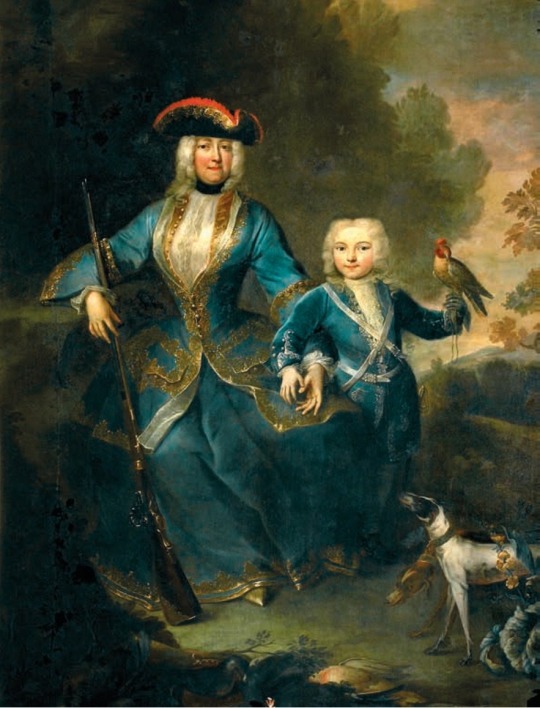
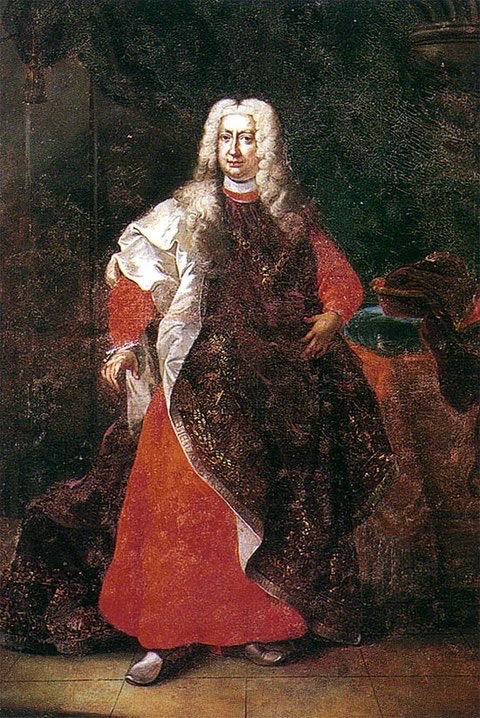
They were so passionate actually that prince Adam himself once hunted a deer with such immense antlers that his record was clogged in the 21st century only! Also those deer antlers have been preserved to this day in a very curious form: they are actually presented on the back side of the facade of Palais Schwarzenberg in Prague.
That’s extremely original, in my opinion! 🦌
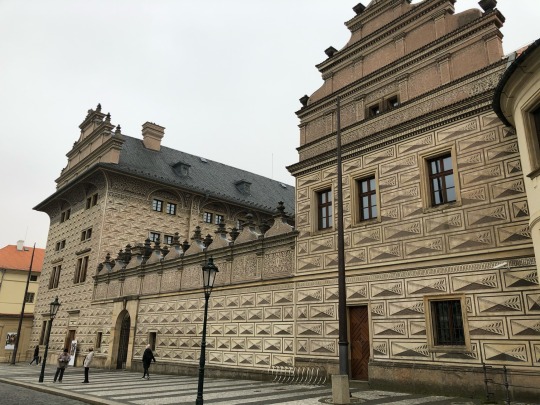


Unfortunately, the hunt became the main reason of prince Adam’s death as well: he was shot dead in 1732… by the emperor of Holy Roman Empire, Charles VI. There he is, the man, the legend *aggressive yelling*!
(Was it some kind of a special entertainment for some emperors in the past, I wonder? Can you say something about that, emperor Napoleon? :/)
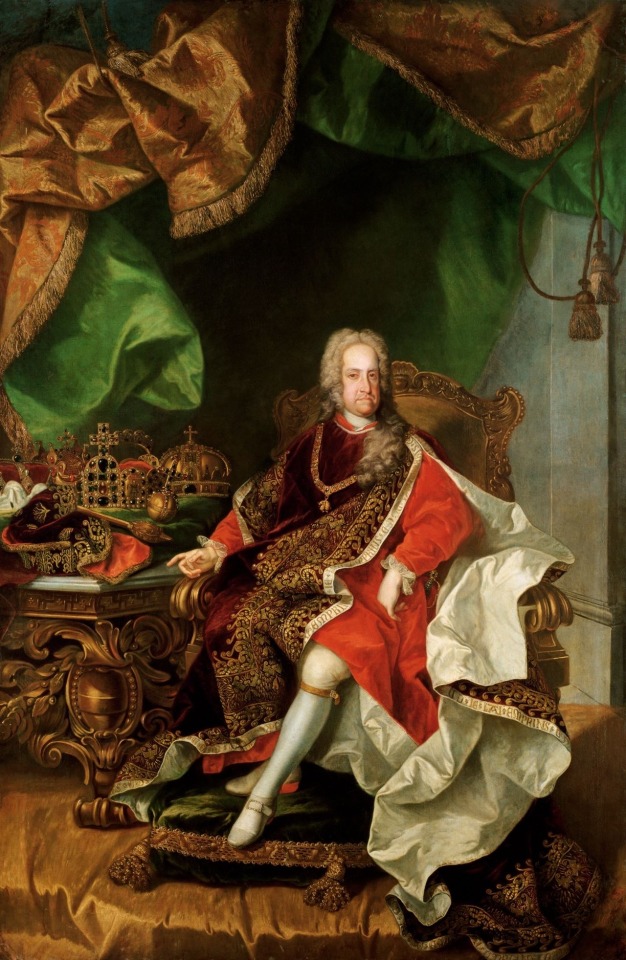
During that disastrous hunt, they happened to track down the exact same animal and were accidentally placed on the opposite sides of a field. When a deer jumped out of the bushes, emperor took a shot and hit prince in the stomach. Emperor’s physician tried to save his life but it didn’t work out. After 12 hours of agony prince Adam passed away... 😔
Feeling somewhat guilty, the emperor made his 10-year-old son a knight of the Order of the Golden Fleece as well. He grew to become one of empress Maria Theresa’s councillors and earned the rank of imperial prince for his House.
But the main question remains: does the life of a devoted nobleman equal to the most prestigious order in the Empire only…

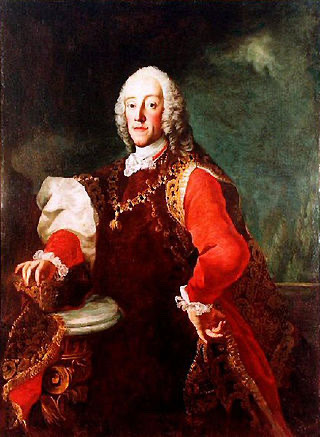
(As a small finishing touch I bring you today the portrait of Johann I zu Schwarzenberg, prince Joseph’s son and field marshal Karl’s father 🤲🇦🇹)
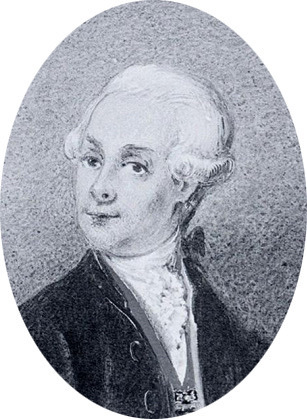
#schwarzenberg#house schwarzenberg#adam franz zu schwarzenberg#eleonore von schwarzenberg#charles vi habsburg#joseph i zu schwarzenberg#johann i zu schwarzenberg#holy roman empire#austrian history#18th century
14 notes
·
View notes
Note
for your "nonsense posts"-list i guess: MBTI types as monarchs?
I’m not sure whether you’re asking for a list of monarchs that fit each type, or a brief description of each type’s potential as a monarch. So… I’ll do a combo of both for the monarchs I know that fit the mold. These are mostly English, since I’m an anglophile history fanatic, and include royal consorts. Do Caesars count?
STJ: principled, dutiful, distrustful of massive shifts, detailed, driven, protective of the status quo, disapproving of their heirs misbehaving. ;) Henry VII, Katharine of Aragon, King Edward VI, Lady Jane Grey, Mary I, King George III, Victoria, ‘Bertie’ (George VI), Elizabeth II, Frederick the Great. (If you include non-monarchs, I’d include George Washington, John Adams, and maybe Abigail Adams – I’m not sure whether Fe/Te.)
STP: bold, larger than life active ‘doers’ and ‘triers’ who refused to sit idle on their throne and got their hands dirty in the trenches of warfare and/or through deliberate action for immediate impact. Alexander the Great, King Richard I, King Edward IV, Henry VIII, Ferdinand of Aragon, King Francis I, Prince Phillip. (If you include non-monarchs, I’d include Mark Antony, and Cesare Borgia. Richard III was also ISP, IMO with an unclear T/F axis.)
SFJ: pragmatic, people-focused humanitarians, emphasis on family, tradition, and social appropriateness / doing what is ‘expected’ of them. Elizabeth of York, Elizabeth Bowes Lyon (The Queen Mother), Jane Seymour, Prince William, Kate Middleton (the last two are guesses based on what little I know of their image).
SFP: bold, larger than life active ‘doers’ who are known as flamboyant and extroverted, focused on living true to their passions, and not wanting to stifle themselves to conform to traditional thinking. Nero, Marie Antoinette, Anne Boleyn, Catherine Howard, Peter the Great (of Russia), Princess Margaret. (If you include non-monarchs, I’d include Michelangelo and Georgiana Cavendish.)
NTJ: long-term thinkers devoted to defying status norms, sometimes out of touch with the real world, but always ruthless strategists / defiant against social norms, sometimes power hungry. Eleanor of Aquitaine (this or ESTJ), Isabella of Spain, Elizabeth I, Prince Albert (INTJ). (If you allow non-monarchs, I’d include Napoleon, Julius Caesar, Rodrigo Borgia, Nikola Telsa, William Pitt, Martin Luther, and Thomas Jefferson.)
NTP: heavily visionary thinkers who often had a deep interest in science and/or technological advancements and scads of additional interests and vocational fascinations beyond the throne. Catherine the Great, perhaps? (Non-monarch examples include Leonardo da Vinci, Benjamin Franklin, Abraham Lincoln, Charles Darwin, Marie Curie, Alexander Hamilton, and Albert Einstein.)
NFJ: long-term visionaries dedicated to changing / shaping their nation in sometimes non-universal or imaginative ways, though not always with their feet on the ground. Alexander II of Russia. I’m welcome to suggestions. (Non-monarchs include the Marquis de Lafayette, Dr. Benjamin Rush, Carl Jung, William Wilberforce, Gandhi.)
NFP: shorter-term visionaries heavily focused on transforming society through cultivating large-scale change, with a humanitarian bent based on individual passions. Sometimes whimsical or overly idealistic, more often leaning toward language and shaping culture through art or literature. I welcome suggestions. (Non-monarchs include William Shakespeare, Sir Thomas More, Charles Dickens, Mark Twain, Virginia Wolfe, John Milton, Oscar Wilde, William Blake.)
- ENFP Mod
#nonsense posts#monarchs#historical typings#question#istj#estj#esfj#isfj#estp#istp#esfp#isfp#entj#intj#enfj#infj#entp#intp#enfp#infp#mbti
169 notes
·
View notes
Text
ADOLPHUS
Duke of Cambridge
(born 1774 - died 1850)

pictured above is a portrait of the Duke of Cambridge, by Sir William Beechey from the 1800s
-------------------- ~ -------------------- ~ --------------------
SERIES - Descendants of the Monarchs of Ireland: Adolphus was a son of George III, King of the United Kingdom, the King of Ireland from 1760.
-------------------- ~ -------------------- ~ --------------------
ADOLPHUS FREDERICK was born in 1774, at the Queen's House in London (the place that would later be known as Buckingham Palace), he was the seventh son of George III, King of Great Britain and Duchess Charlotte of Mecklenburg-Strelitz.
A member of the British branch of the HOUSE OF HANOVER, he was from birth a PRINCE OF GREAT BRITAIN.
The British Hanoverians kept their ties to the Electorate of Hanover in the Holy Roman Empire. In 1786 he and his older brothers Prince Ernest Augustus and Prince Augustus Frederick were sent to study at the University of Göttingen, that had been founded in 1734 by their great-grandfather Georg II, Elector of Hanover (also George II, King of Great Britain).
Around 1789-91 he and his brother Prince Ernest Augustus joined the Hanoverian Army and began their military training. He was soon sent to the battlefield in the War of the First Coalition against the French Republic.
At 1800-01 the Acts of Union that united Great Britain and Ireland were passed and he became a PRINCE OF THE UNITED KINGDOM.
During the War of the Second Coalition he acted as a mediator in Prussia and in 1801 his father created him DUKE OF CAMBRIDGE, EARL OF TIPPERARY and BARON CULLODEN.
He continued to fight against France in the other Coalition Wars that were part of the Napoleonic Wars until the first defeat of Napoléon I, Emperor of the French in 1814.
From 1813 he acted as MILITARY GOVERNOR OF HANOVER. And after the Electorate was recognized as Kingdom in 1814 he acted as GOVERNOR GENERAL and as VICEROY from 1816, serving three Monarchs: his father King Georg III; his brother King Georg IV; and another brother King Wilhelm IV.
By 1817 the Hanoverian British Royal Family suffered a succession crisis after the death of Princess Charlotte of Wales while giving birth, as she was the only child of George, Prince Wales (the eldest brother of the Duke of Cambridge) and the the second-in-line to the throne.
Some of King George III's sons were married but their children rather died early or were not considered legitimate, and the daughters were too old to even try to have children of their own. So the sons who were still single, including the Duke of Cambridge, rushed to get married and produce heirs to the throne.
In 1818 he married AUGUSTE WILHELMINE LOUISE, a Princess of Hesse-Kassel as the daughter of Prince Friedrich of Hesse-Kassel and Princess Karoline of Nassau-Usingen. They lived in Hanover where their three children were born.
After the death of his brother King William IV in 1837 he was succeeded by their niece Queen Victoria in the United Kingdom. However do to the Salic Law she could not succeed in Hanover and his eldest living brother succeeded as Ernst August I, King of Hanover.
With Hanover having its own King living there, there was no need for a Viceroy anymore and the Duke of Cambridge returned to England with his family.
Aged 76 the Duke of Cambridge died, in 1850 at his London residence, Cambridge House.
-------------------- ~ -------------------- ~ --------------------
Descendants of the Duke of Cambridge include five Monarchs of the United Kingdom:
Princess Mary of Teck (wife of King George V), her sons
King Edward VIII and
King George VI, her granddaughter
Queen Elizabeth II, and her great-grandson
King Charles III.
-------------------- ~ -------------------- ~ --------------------
Check my post on ADOLPHUS' father and his connections to the Monarchs of Ireland!
His father was George III, King of the United Kingdom - the King of Ireland between 1760-1800/01.
#adolphus#prince adolphus#duke of cambridge#british prince#house of hanover#hanover#british royals#british royal family#royals#royalty#monarchy#monarchies#royal history#british history#european history#world history#history#history lover#18th century#19th century#georgian royals#georgian era#regency era#regency england#victorian royals#victorian era#george iii#george iv#queen victoria#history with laura
3 notes
·
View notes
Photo


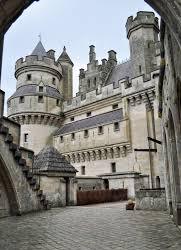



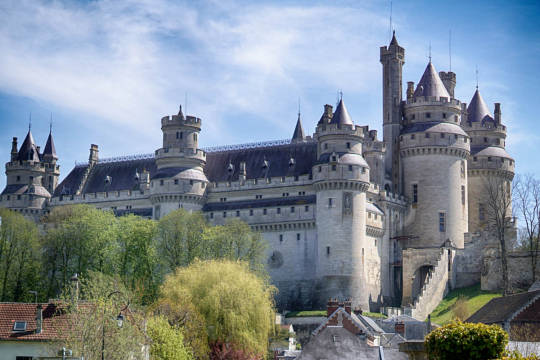
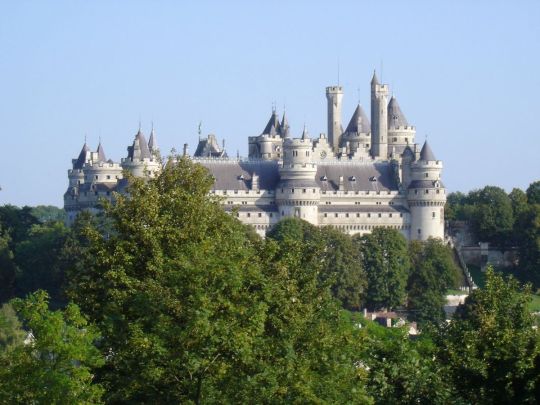
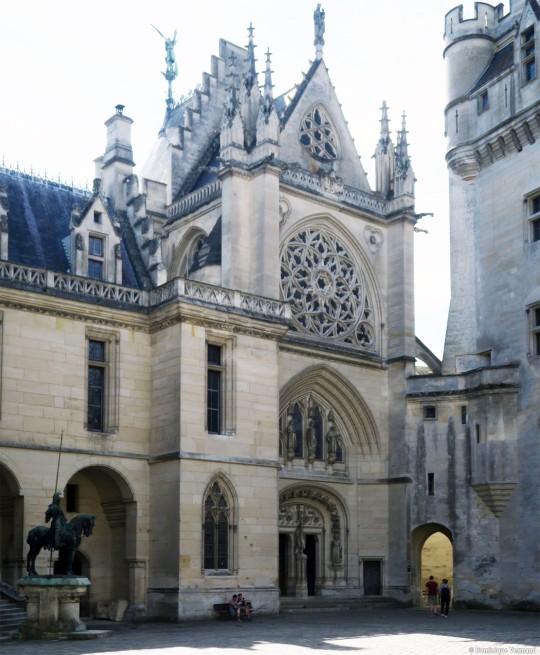
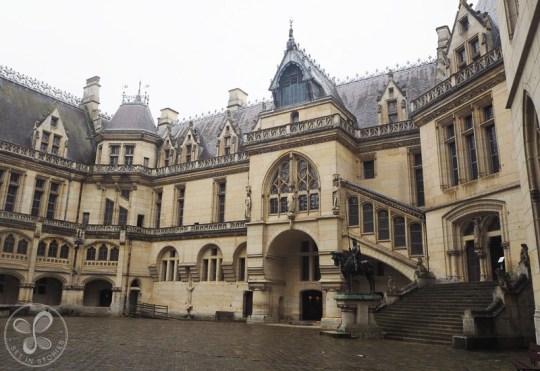
Man’s Impact on the Environment
Château de Pierrefonds
Pierrefonds, Oise (Picardy), France
The Château de Pierrefonds (French pronunciation: [ʃɑto də pjɛʁfɔ̃]) is a castle situated in the commune of Pierrefonds in the Oise département (Picardy) of France. It is on the southeast edge of the Forest of Compiègne, northeast of Paris, between Villers-Cotterêts and Compiègne.
The Château de Pierrefonds includes most of the characteristics of defensive military architecture from the Middle Ages, though it underwent a major restoration in the 19th century.
In the 12th century, a castle was built on this site. Two centuries later, in 1392, King Charles VI turned the County of Valois (of which Pierrefonds was part) into a Duchy and gave it to his brother Louis, Duke of Orléans. From 1393 to his death in 1407, the latter had the castle rebuilt by the court architect, Jean le Noir.
In March 1617, during the early troubled days of Louis XIII's reign, the castle, then the property of François-Annibal d'Estrées (brother of the beauty Gabrielle d'Estrée), who joined the "parti des mécontents" (party of discontent) led by Henri II, Prince of Condé, was besieged and taken by troops sent by Richelieu, the secretary of state for war. Its demolition was started, but not carried through to the end because of the enormity of the task. The exterior works were razed, the roofs destroyed and holes made in the towers and curtain walls.
The castle remained a ruin for more than two centuries. Napoleon I bought it in 1810 for less than 3,000 francs. During the 19th century, with the rediscovery of the architectural heritage of the Middle Ages, it became a "romantic ruin": in August 1832, Louis-Philippe gave a banquet there on the occasion of the marriage of his daughter Louise to Léopold de Saxe-Cobourg Gotha, first king of the Belgians. Among other artists, Corot depicted the ruins in several works between 1834 and 1866. The Château de Pierrefonds has been classified as a monument historique by the French Ministry of Culture since 1848.
Louis-Napoléon Bonaparte (later Napoleon III of France) visited the castle in 1850. As emperor, he asked Viollet-le-Duc in 1857 to undertake its restoration, continuators are Maurice Ouadou and Juste Lisch until 1885. There was no question of a simple repair to the habitable parts (the keep and annexes): the "picturesque" ruins in front were to be kept for decor. In 1861, the project grew in scale: the sovereign wanted to create an imperial residence, so the castle was to be entirely rebuilt. The works, which would cost 5 million francs, of which 4 million were to come from the civil list, were stopped in 1885, six years after the death of Viollet-le-Duc. The departure of Napoléon III had halted the reconstruction and, through lack of money, the decoration of rooms was unfinished. Inside, Viollet-le-Duc produced more a work of invention than restoration (polychrome paintings). He imagined how the castle ought to have been, rather than basing his work on the strict history of the building. On the other hand, with the exterior he showed an excellent knowledge of the military architecture of the 14th century.
12 notes
·
View notes
Text
Maria Leopoldina, Queen of Portugal (Wife of King Pedro IV)
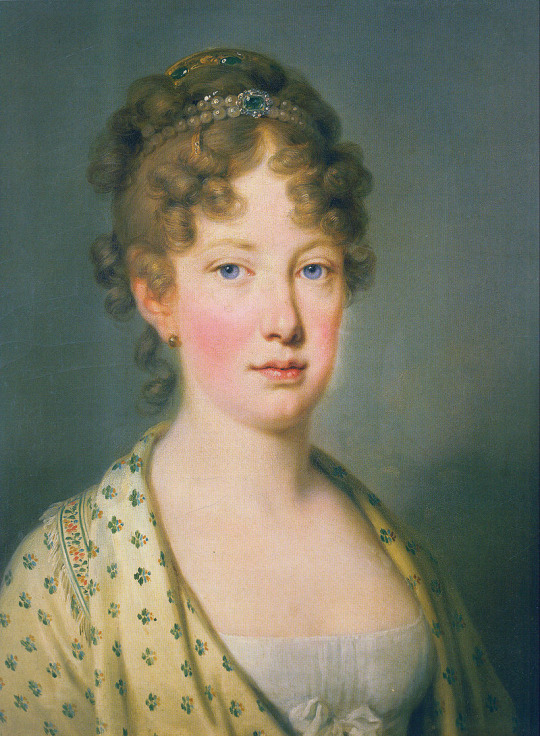
Tenure: 10 March 1826 – 2 May 1826
Maria Leopoldina of Austria (22 January 1797 – 11 December 1826) was an archduchess of Austria, Empress consort of Brazil and Queen consort of Portugal.
She was born Caroline Josepha Leopoldine Franziska Ferdinanda of Habsburg-Lorraine in Vienna, Austria, the daughter of Holy Roman Emperor Francis II,

and his second wife, Maria Teresa of Naples and Sicily.
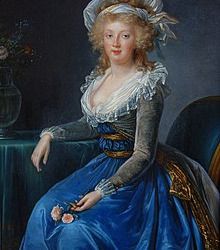
Among her many siblings were Emperor Ferdinand I of Austria
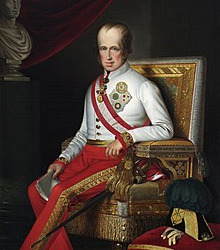
and Marie Louise, Duchess of Parma,
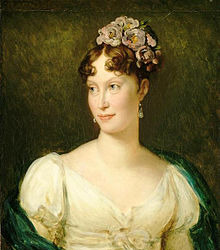
the wife of Napoleon Bonaparte.
Leopoldina was born on 22 January 1797 in Schönbrunn Palace, in Vienna, Archduchy of Austria. She was given the name Caroline Josepha Leopoldine Franziska Ferdinanda, according to her biographer Carlos H. Oberacker, and confirmed by Bettina Kann in her work "Cartas de uma Imperatriz", who mentioned a contemporary source: the Austrian newspaper Wiener Zeitung of 25 January 1797, who gave the news of the birth of the Archduchess three days before with her full name. According to Oberacker, the name "Maria" wasn't present in the preserved baptismal record of the Archduchess, and she began to use it only during her journey to Brazil, where she began to be named Maria Leopoldina in all documents, including the Constitutional oath of 1822. According to another theory presented by Oberacker, the Archduchess probably began to use the name "Maria" due to her great devotion to the Virgin Mary and because all her sisters-in-law used this name.

She was raised in accordance with the educational principles laid down by her grandfather, Emperor Leopold II. Among these was the habit of exercising her handwriting by writing the following text:
“Do not oppress the poor. Be charitable. Do not complain about what God has given you, but improve your habits. We must strive earnestly to be good.”
In addition, she and her sisters were taught to speak French and Latin. They were also educated in drawing, piano, riding and hunting. Her mother died when she was ten years old and her father went on to remarry Maria Ludovika of Austria-Este.
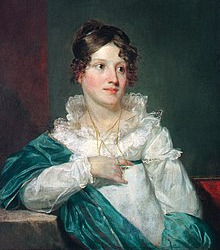
Her late mother was a soprano and Leopoldina had the chance of meeting Johann Wolfgang von Goethe
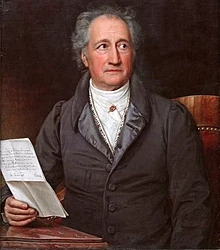
in 1810 and 1812, when she went to Carlsbad with her stepmother. Her passions included natural sciences, especially botany and mineralogy. She was formed according to the three Habsburg principles: discipline, piety and a sense of duty.
Although Maria Theresa of Naples and Sicily was her birth mother, Leopoldina always considered Maria Ludovika d'Este, her stepmother, to be her mother and she grew up with Ludovika as her "spiritual mother".
On 24 September 1816 it was announced by Leopoldina's father that Pedro of Braganza wished to take a Habsburg princess as his wife. Klemens von Metternich suggested that it should be Leopoldina to go get married, as it was "her turn" to become a wife. Two ships were prepared and in April 1817 scientists, painters, gardeners and a taxidermist, all with assistants, travelled to Rio de Janeiro ahead of Leopoldina, whom, in the meantime, studied the history and geography of her future home and learned Portuguese. During these weeks Leopoldina compiled and wrote a vade mecum, a unique document the like of which has never been produced by any other Habsburg princess.
On 13 May 1817 Leopoldina was married to Dom Pedro per procuram (by proxy) in Vienna. At the ceremony the bridegroom was represented by Leopoldina’s uncle, Archduke Charles.
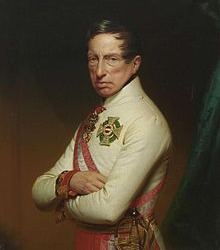
Embarkation took place in Livorno on 13 August 1817

among much celebration, and after an adventure-filled voyage lasting 81 days, Leopoldina arrived in Rio de Janeiro on 5 November and finally met her husband.
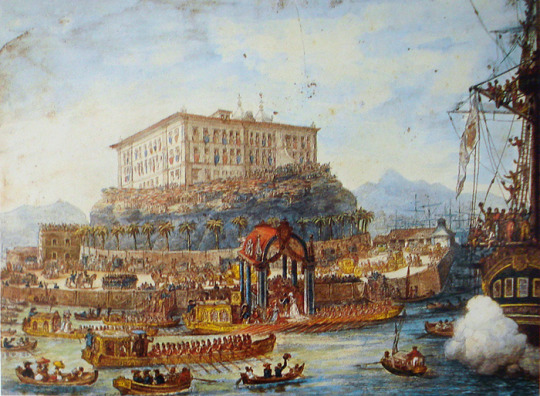
From a distance Pedro initially appeared to Leopoldina to be a perfect, well-educated gentleman, but the reality was very different. Dom Pedro was a year younger than Leopoldina and sadly rarely measured up to the descriptions given by the matchmakers. His temperament was impulsive and choleric, and his education but modest. Even spoken communication between the young married couple proved difficult, as Pedro spoke very little French and his Portuguese could only be described as vulgar.
In keeping with Portuguese tradition, at the age of eighteen Pedro of Bragança not only had a string of amorous adventures behind him and was principally interested in horse racing and love affairs, but in 1817 (the year of his marriage to Leopoldina) he was living as if in wedlock with French dancer Noemie Thierry, who was finally removed from the court by his father a month after Leopoldina's arrival in Rio de Janeiro.
The young married couple took up residence in six relatively small rooms in the Palace of São Cristóvão. The inner courtyard and path to the stables were unpaved and the tropical rainfall quickly turned everything to mud. There were insects everywhere, including in their clothing, for the uniforms and court regalia made of velvet and plush rotted and turned mouldy in the heat and humidity.
On 25 April 1821, the court returned to Portugal. A fleet of 11 ships took the king, the court, the royal house and the royal treasury, and only Prince Pedro remained in Brazil as regent of the country, with ample powers counterbalanced by a regency council. At first Pedro was incapable of dominating the chaos: the situation was dominated by the Portuguese troops, in anarchic conditions. The opposition between Portuguese and Brazilians became increasingly evident. It is clear from Leopoldina's correspondence that she has warmly espoused the cause of the Brazilian people and even desired the independence of the country and is therefore loved and venerated by the Brazilians.
According to Ezekiel Ramirez, below, the signs of a nascent Brazilian unit as an independent nation in the southern provinces were visible, but the north supported the Lisbon Cortes and called for regional independence. If the Prince Regent had left the country at that moment, Brazil would be lost to Portugal because the courts of Lisbon repeated the same error that led the Spanish courts to lose the colonies, seeking to establish direct contacts with each province in particular.
In Rio, thousands of signatures collected required the regents to remain in Brazil. "José Bonifácio de Andrada e Silva's courageous attitude toward Portuguese arrogance greatly encouraged the aspirations for unity that existed in the southern provinces, especially in São Paulo. A highly educated men led this movement." After Fico's day, 9 January 1822, a new ministry was organized under the leadership of José Bonifácio, "strictly monarchist", and the Prince Royal soon won the trust of the people. On 15 February 1822 the Portuguese troops left Rio, and their departure represented the dissolution of the ties between Brazil and the metropolis. The prince was triumphantly received in Minas Gerais.
When her husband, prince regent, traveled to São Paulo in August 1822 to pacify politics (which culminated in the proclamation of Brazil's independence in September), Leopoldina exercised the regency. Great was his influence in the process of independence. The Brazilians were already aware that Portugal intended to call Pedro back, relegating Brazil again to the status of a simple colony rather than a kingdom united to that of Portugal. There were fears that a civil war would separate the Province of São Paulo from the rest of Brazil. Pedro gave power to Leopoldina on 13 August 1822, appointing her head of the Council of State and Acting Princess Regent of the Kingdom of Brazil, with legal powers to govern the country during his absence and set out to appease São Paulo.
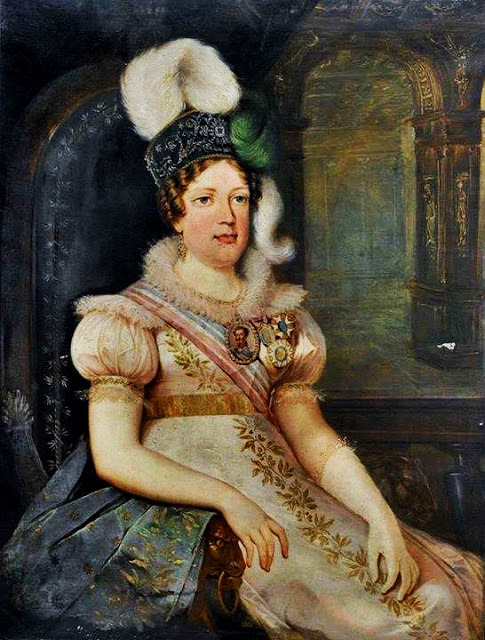
The Princess received news that Portugal was preparing action against Brazil and, without time to wait for Pedro's return, Leopoldina, advised by José Bonifácio de Andrada e Silva, and using his attributes as interim head of government, met in the morning of 2 September 1822, with the Council of State, signing the decree of Independence, declaring Brazil separate from Portugal. The Princess sends Pedro a letter, along with another letter from José Bonifácio, as well as comments from Portugal criticizing the actions of her husband and King João VI. It demands that Pedro proclaim the Independence of Brazil and, in the letter, warns: "The pommel is ripe, pick it up already, or it will rot."
The officer arrived at the prince on 7 September 1822. Leopoldina had also sent papers received from Lisbon, and comments from Antônio Carlos Ribeiro de Andrada, deputy to the courts, for which the Prince-Regent learned of criticism of him in the metropolis. The position of João VI and all his ministry, dominated by the courts, was difficult.
While awaiting the return of Pedro, Leopoldina, the interim ruler of an already independent Brazil, idealized the flag of Brazil, in which she mixed the green of the House of Bragança and the golden yellow of the House of Habsburg. Other authors say that Jean-Baptiste Debret, the French artist who designed what he saw in Brazil in the 1820s, was the author of the national pavilion that replaced that of the old Portuguese court, symbol of the oppression of the old regime. Debret is the design of the beautiful imperial flag, in collaboration with José Bonifácio de Andrada e Silva, in which the green rectangle of the Bragança represented the forests and the yellow rhombus, color of the Habsburg-Lorraine dynasty, represented the gold.
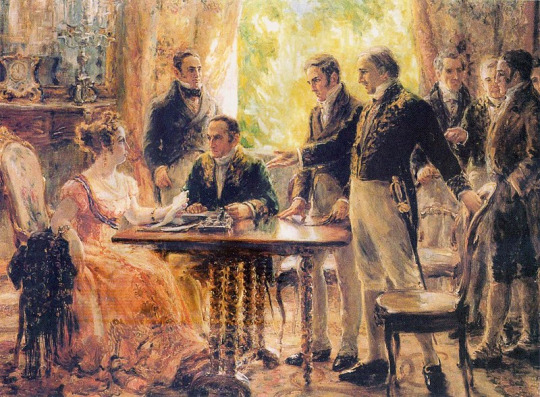
Maria Leopoldina became Brazil's first empress consort. She also played an important role in the process of issuing a Declaration of Independence. On 2 September 1822, a new decree with demands from Lisbon arrived in Rio de Janeiro, while Prince Pedro was in São Paulo.
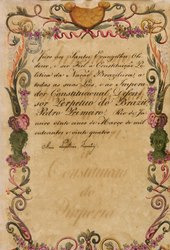
Leopoldina, advised by José Bonifácio, and using her power as Princess Regent, met on 2 September 1822 with the Council of Ministers. She decided to send her husband the news along with a letter advising him to declare Brazil's independence and warned him, "The fruit is ready, it's time to harvest." Prince Pedro declared the country's independence upon receiving the letter on 7 September 1822.
When his father, João VI, died on 10 March 1826, Pedro inherited the Portuguese throne as King Pedro IV, while remaining Emperor Pedro I of Brazil. Maria Leopoldina thus became both Empress consort of Brazil and Queen consort of Portugal. However, two months later, Pedro was forced to give up the Portuguese throne to their seven-year-old daughter Maria.
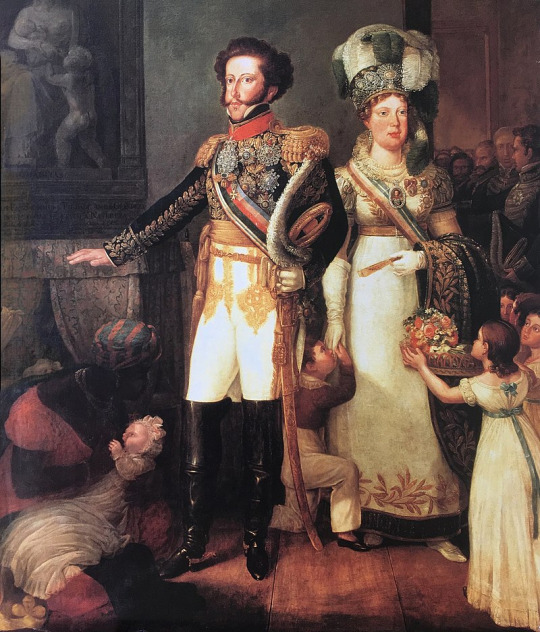
At the end of November 1826, Pedro traveled to Cisplatina (now Uruguay) to join his soldiers. To mark the occasion there was a large farewell reception on 20 November 1826, and Pedro demanded that both women, Maria Leopoldina and his official mistress Domitila de Castro, Marchioness of Santos, appear together before the ecclesiastical and diplomatic dignitaries and receive his kiss on the hand. With the fulfillment of this demand, Maria Leopoldina would have officially recognized her husband's mistress, and for this she refused to appear at the reception. This caused a bitter argument with Pedro, who departed with no resolution to the situation.

Shortly after, Maria Leopoldina became ill, had spells of fever, became delirious at times, and then suffered a miscarriage on 2 December 1826. She died eight days later, on 11 December, five weeks before her thirtieth birthday. She was buried on 14 December 1826 in Rio de Janeiro, in the church of the Ajuda Convent.
Maria Leopoldina had seven children with her husband King Pedro IV of Portugal:
Maria II of Portugal (4 April 1819 –15 November 1853) Queen of Portugal from 1826 until 1853. Maria II's first husband, Auguste de Beauharnais, 2nd Duke of Leuchtenberg, died a few months after the marriage. Her second husband was Prince Ferdinand of Saxe-Coburg and Gotha, who became King Dom Fernando II after the birth of their first child. She had eleven children from this marriage. Maria II was heir to her brother Pedro II as Princess Imperial until her exclusion from the Brazilian line of succession by law no. 91 of 30 October 1835.
Miguel, Prince of Beira (26 April 1820) Prince of Beira from birth to his death.
João Carlos, Prince of Beira (6 March 1821 – 4 February 1822) Prince of Beira from birth to his death.
Princess Januária of Brazil (11 March 1822 – 13 March 1901) Married Prince Luigi, Count of Aquila, son of Don Francesco I, King of the Two Sicilies. She had four children from this marriage. Officially recognized as an Infanta of Portugal on 4 June 1822, she was later considered excluded from the Portuguese line of succession after Brazil became independent.
Princess Paula of Brazil (17 February 1823 – 16 January 1833) She died age 9, probably of meningitis. Born in Brazil after its independence, Paula was excluded from the Portuguese line of succession.
Princess Francisca of Brazil (2 August 1824 – 27 March 1898) Married Prince François, Prince of Joinville, son of Louis Philippe I, King of the French. She had three children from this marriage. Born in Brazil after its independence, Francisca was excluded from the Portuguese line of succession.
Pedro II of Brazil (2 December 1825 –5 December 1891) Emperor of Brazil from 1831 until 1889. He was married to Teresa Cristina of the Two Sicilies, daughter of Don Francesco I, King of the Two Sicilies. He had four children from this marriage. Born in Brazil after its independence, Pedro II was excluded from the Portuguese line of succession and did not become King Dom Pedro V of Portugal upon his father's abdication.
14 notes
·
View notes
Text
Thank you!😁❤️❤️❤️❤️❤️
Royal tiaras through time
Strathmore Rose Tiara worn by Queen Elizabeth, 1923
The history of royal tiaras is as long and fascinating as the headgear is sparkling. Take the tiaras worn by the late Diana, Princess of Wales, for instance. She married Prince Charles wearing a family heirloom of her own aristocratic lineage, the Spencer tiara, but the Cambridge Lovers’ Knot - with its 19 diamond arches and swinging pearls - was said to be among her favourites. (She famously teamed it with Catherine Walker’s pearl- and sequin-studded Elvis dress for a state dinner in 1989). Originally commissioned by Queen Mary, the Cambridge Lovers’ Knot was passed down to her granddaughter, Queen Elizabeth II, and has most recently been seen on the head of the Duchess of Cambridge.
Lotus Flower Tiara worn by Queen Elizabeth, circa 1930
Other British royal family sparklers of note include the Lotus Flower tiara - a favourite of Princess Margaret’s, the Egyptian-style headpiece originally belonged to the Queen Mother - and the Cartier Halo Scroll, which dates back to 1936 and was worn by the Duchess of Cambridge on her wedding day.
Cartier Halo Scroll Tiara worn by Princess Margaret, 1954
Among the oldest tiaras still in use is the Swedish royal family’s Cameo Tiara - a rich gold diadem, with seven delicate cameos framed in opulent seed pearl accents - was gifted to Empress Joséphine by Napoleon in 1809. The empress’s granddaughter, Josephine of Leuchtenberg, inherited it and took it with her into the Swedish royal family when she wed the future King Oscar I of Sweden and Norway. It has since been worn by many of the women in the household of King Carl Gustaf, from Princess Birgitta’s 1961 nuptials to Princess Victoria’s own wedding in 2010.
Not all royal households take the same inheritance approach to their gems though. The Japanese imperial household traditionally provides each family member a tiara of their own, either when they marry into the family, or when they come of age at 20. The most recent addition to the royal parure was Princess Kako of Akishino coming of age gift, an all-white scroll motif and diamond cluster set - including matching earrings, a brooch, bracelet, necklace and, of course, tiara - designed by Mikimoto.
Cameo Tiara worn by Princess Birgitta, 1961
Girls of Great Britain and Ireland Tiara worn by Queen Elizabeth II, 1961
Persian Turquoise Tiara worn by Princess Margaret, 1966
Queen Alexandra’s Kokoshnik Tiara worn by Queen Elizabeth II, 1969
Poltimore Tiara worn by Princess Margaret. 1969
Ruby & Diamond Parure Van Cleef & Arpels Set worn by Princess Grace, 1973
Braganza Tiara worn by Queen Silvia, 1976
Burmese Ruby Tiara worn by Queen Elizabeth II, 1977
Grand Duchess Vladimir Tiara worn by Queen Elizabeth, 1980
Spencer Tiara worn by Princess Diana, 1983
Princess Andrew’s Meander Tiara worn by Princess Anne, 1988
George VI Victorian Suite Tiara worn by Queen Elizabeth II, 1996
Cartier Pearl Drop Tiara worn by Princess Caroline, 1996
Four Button Tiara worn by Princess Victoria, 1997
Halo Diamond Cartier Tiara worn by Queen Rania, 2000
Diamond Floral Tiara won by Princess Dayangku Sarah Binti Pengiran Salleh Ab Rahaman, 2004
Modern Fringe Tiara worn by Princess Madeleine, 2005
Prussian Tiara worn by Princess Letizia, 2009
Cameo Tiara worn by Princess Victoria, 2010
Cartier Halo Scroll Tiara worn by the Duchess of Cambridge, 2011
Princess Mako’s Tiara worn by Princess Mako, 2011
Pearl Fleur de Lys Tiara worn by Queen Letizia, 2015
Cambridge Lover’s Knot Tiara worn by the Duchess of Cambridge, 2016
Princess Eugenie wears the Greville Emerald Kokoshnik tiara in 2019
Wonderful! Thank you so much!😁❤️❤️❤️❤️❤️
24 notes
·
View notes
Text
Events (before 1900)
306 – Constantine I is proclaimed Roman emperor by his troops.
315 – The Arch of Constantine is completed near the Colosseum in Rome to commemorate Constantine I's victory over Maxentius at the Milvian Bridge.
677 – Climax of the Siege of Thessalonica by the Slavs in a three-day assault on the city walls.
864 – The Edict of Pistres of Charles the Bald orders defensive measures against the Vikings.
1137 – Eleanor of Aquitaine marries Prince Louis, later King Louis VII of France, at the Cathedral of Saint-André in Bordeaux.
1139 – Battle of Ourique: The Almoravids, led by Ali ibn Yusuf, are defeated by Prince Afonso Henriques who is proclaimed King of Portugal.
1261 – The city of Constantinople is recaptured by Nicaean forces under the command of Alexios Strategopoulos, re-establishing the Byzantine Empire.
1467 – The Battle of Molinella: The first battle in Italy in which firearms are used extensively.
1536 – Sebastián de Belalcázar on his search of El Dorado founds the city of Santiago de Cali.
1538 – The city of Guayaquil is founded by the Spanish Conquistador Francisco de Orellana and given the name Muy Noble y Muy Leal Ciudad de Santiago de Guayaquil.
1547 – Henry II of France is crowned.
1554 – The royal wedding of Mary I and Philip II of Spain celebrated at Winchester Cathedral.
1567 – Don Diego de Losada founds the city of Santiago de Leon de Caracas, modern-day Caracas, the capital city of Venezuela.
1591 – The Duke of Parma is defeated near the Dutch city of Nijmegen by an Anglo-Dutch force led by Maurice of Orange.
1593 – Henry IV of France publicly converts from Protestantism to Roman Catholicism.
1603 – James VI and I and Anne of Denmark are crowned in Westminster Abbey.
1609 – The English ship Sea Venture, en route to Virginia, is deliberately driven ashore during a storm at Bermuda to prevent its sinking; the survivors go on to found a new colony there.
1668 – A magnitude 8.5 earthquake strikes eastern China, killing over 42,000 people.
1693 – Ignacio de Maya founds the Real Santiago de las Sabinas, now known as Sabinas Hidalgo, Nuevo León, Mexico.
1718 – At the behest of Tsar Peter the Great, the construction of the Kadriorg Palace, dedicated to his wife Catherine, begins in Tallinn.
1722 – Dummer's War begins along the Maine-Massachusetts border.
1783 – American Revolutionary War: The war's last action, the Siege of Cuddalore, is ended by a preliminary peace agreement.
1788 – Wolfgang Amadeus Mozart completes his Symphony No. 40 in G minor (K550).
1792 – The Brunswick Manifesto is issued to the population of Paris promising vengeance if the French royal family is harmed.
1797 – Horatio Nelson loses more than 300 men and his right arm during the failed conquest attempt of Tenerife (Spain).
1799 – Napoleon Bonaparte defeats a numerically superior Ottoman army under Mustafa Pasha at the Battle of Abukir.
1814 – War of 1812: An American attack on Canada is repulsed.
1824 – Costa Rica annexes Guanacaste from Nicaragua.
1837 – The first commercial use of an electrical telegraph is successfully demonstrated in London by William Cooke and Charles Wheatstone.
1853 – Joaquin Murrieta, the famous Californio bandit known as the "Robin Hood of El Dorado", is killed.
1866 – The United States Congress passes legislation authorizing the rank of General of the Army. Lieutenant General Ulysses S. Grant becomes the first to be promoted to this rank.
1868 – The Wyoming Territory is established.
1869 – The Japanese daimyōs begin returning their land holdings to the emperor as part of the Meiji Restoration reforms. (Traditional Japanese Date: June 17, 1869).
1894 – The First Sino-Japanese War begins when the Japanese fire upon a Chinese warship.
1897 – American author Jack London embarks on a sailing trip to take part in the Klondike's gold rush, from which he wrote his first successful stories.
1898 – Spanish–American War: The American invasion of Spanish-held Puerto Rico begins, as United States Army troops under General Nelson A. Miles land and secure the port at Guánica.
0 notes
Link
What do Napoleon, the son of a French lawyer, and being kind to prisoners of war have to do with the Swedish monarchy? Significantly more than you would think. In 1810, Jean Baptiste Bernadotte was elected Prince Royal of Sweden, and eight years later became the founding king of the dynasty that rule Sweden to this day, proving that, contrary to what Michael Palin said, sometimes you do vote for a king.
To understand the Bernadotte's rise to power, you have to understand late eighteenth century Europe. In the summer of 1789, Louis XVI, an absolute monarch from a long line of absolute monarchs attempted to solve his financial issues using the nominal democratic system France already had in place. This went poorly, and resulted in the common people calling for a new constitution, taking the Bastille, forcing Louis and his family from their opulent home in Versailles, and culminated in a lot of very wealthy and important people losing a very important appendage to the guillotine. "What does this have to do with the price of meatballs in Sweden", you ask? Well, the act of dethroning and de-heading Louis, scion of the long and noble line of Bourbon, sent a shock across Europe. After all, if the French monarch could be thrown out of power, and a 'democracy' instituted in less than two years, were any of the other absolute monarchs of Europe safe?
With the English kicked out of their American colonies, and the French monarchy quite literally headless, it seemed that the age of the 'enlightened despot', or the benevolent philosopher dictator was coming to an end. This was particularly worrying to the Swedish king Gustav III who was a great admirer of Marie Antoinette. He was a little more politically savvy than Louis XVI, and he survived his initial summoning of the Riksdag--or the (at the time) nominal Swedish democratic system. However, he made enemies, and bit a bullet Abraham Lincoln style in 1792.
Gustav III left his throne to his thirteen year old son, Gustav IV, or Gustav Adolf. The years in which Gustav IV's uncle served as regent were the best of his reign. Gustav Adolf grew into a paranoid and arrogant king, which lead to him losing Finland, Pomerania, and the Aland islands. He was forced to abdicate, and handed the throne to his uncle, Charles XIII.
Charles XIII wasn't so much the best choice for king as he was the only choice for king. The House of Vasa had been struggling since the abdication of Queen Kristina in 1654, and Charles had only tenuous claims to the throne himself. Furthermore, Charles was childless and a bit senile. It was clear to Charles and the ruling class of Sweden that if they wanted to continue to have a monarchy, they would have to elect somebody. The year was 1809.
Now, the 'election' of a monarch wasn't an uncommon thing, the Vasa's themselves had been elected. In cases where a royal line was dying out without an heirs, or in the case of creating an entirely new country, the nobility of a country would take a look at all the princes of Europe, and see who they liked. This sort of thing had been happening since medieval times, and in the tumultuous world of nineteenth century Europe, it was nothing to balk at.
Two distant cousins of Charles XIII were nominated as heirs, but one was an idiot, and the other died. There was a whole host of unsuitable candidates for Crown Prince of Sweden, and a significant portion of the Riksdag were sick of it. They wanted a successful monarch, someone who wasn't an idiot who would lose Finland. And who was more successful than the plucky young Corsican ruling France?
There was no way in hell that any self respecting Swede was going to invite Napoleon to be their king--they were an independent country after all. But maybe one of his brothers, or one of his Marshals, the military geniuses who had won Napoleon his vast empire.
Enter Jean-Baptiste Bernadotte. A commoner from Southern France, he ran away from his apprenticeship as a lawyer at age eighteen to join the French army. Like Napoleon, he had used the chaos of the French Revolution to rise rapidly through the ranks, eventually becoming a general. He supported Napoleon on his campaigns, eventually being made the French Minister of War, a Marshal, and then the Prince of Ponte-Corvo, a small principality in Italy.
Bernadotte was an attractive candidate for a number of reasons. He was a proved general, a proved administrator, and he already had an heir. He was extremely popular in Sweden, having received and made peace with Swedish officers independently of Napoleon's commands. He was also unemployed, which was very convenient for the Swedes.
Most importantly, he had been kind to the right person back in the day. Baron Otto Morner was about to become the brother-in-law to the Swedish Chancellor, and he was a big fan of Bernadotte. Bernadotte had been a major player in the Battle of Lubeck, during which Bernadotte and the French had roundly kicked Prussian and Swedish ass, but, like, nicely. Bernadotte captured a contingent of Swedish soldiers, and was so nice to them that Otto Morner was still a huge Bernadotte stan four years later. While in Paris, Morner brought the proposition to Bernadotte, who was incredulously flattered.
There was a lot going against Jean Baptiste Bernadotte however, and he knew it. He didn't speak Swedish, he wasn't Lutheran, and all of this was seemingly happening behind Napoleon's back. Napoleon and Jean Baptiste had never been great friends, and they certainly weren't bosom friends at the time, but Bernadotte said that the religion and the language thing could be fixed easily, and that, should Emperor Napoleon and King Charles agree, he would be happy to have his name up for consideration.
There was a hiccup. Morner hadn't been acting entirely officially. He was just a lieutenant, not an ambassador. An ambassador had, in fact, been sent to Napoleon, asking him on his opinion on who should succeed Charles XIII. Napoleon had backed King Frederick VI of Denmark-Norway, hoping to unite Scandinavia under a friendly flag. When he found out that Jean Baptiste had been offered the position, he wasn't crazy about Bernadotte being on the Swedish throne, but he loved the idea of a Frenchman on the throne. He went to his ex-stepson, Eugene, the Viceroy of Italy, and offered the position to him. Eugene refused. Napoleon decided to, well, not support Bernadotte, because if Bernadotte failed it would be embarrassing for Napoleon, but he wasn't not not supporting Bernadote.
Jean Baptiste discussed it with his wife, and after getting Napoleon's 'do it if you want', formally submitted his name for consideration. Baron Morner was an enthusiastic hype-man, campaigning for Bernadotte much like how modern pundits campaign for elected officials. Though there was a significant faction in favor of Frederick VI, and King Charles still wanted to elect his idiot cousin, Jean Baptiste was elected unanimously.
There were a few hurdles that had be overcome before Jean Baptiste could become Prince Royal, however. He had to become a Lutheran, that was non-negotiable. He also had to promise not to give any Swedish posts to Frenchmen, and allow Charles XIII to adopt him. Jean acceded, and took the name Charles John, becoming king Charles John XIV, or Carl Johann XIV to the Swedes.
The new Charles was good to his word, and any worries of a French takeover of Sweden were assuaged for good in 1813 when Charles and Swedish forces joined the sixth coalition to fight against Napoleon. Charles was Crown Prince for about eight years, from 1810 to 1818. During this time, he conquered Norway, and unified Sweden and Norway again. By the time he became King, he had thoroughly won over his new people.
Jean Baptiste Bernadotte's legacy lives on today in the ruling family of Sweden. The current king, Carl Gustav XVI is the great, great, great, great grandson of Jean Baptiste. When Carl Gustav's daughter, Crown Princess Victoria, becomes Queen Regnant, she will be the eighth Bernadotte monarch.
4 notes
·
View notes
Photo
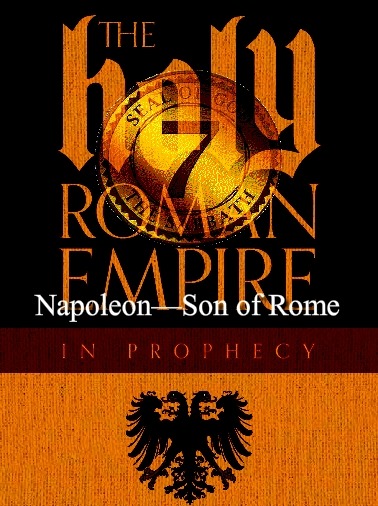
“Iam the successor, not of Louis xvi, but of Charlemagne.”—Napoleon Bonaparte
Most history books teach that the Holy Roman Empire began with Charlemagne and ended with the Habsburgs sometime during the 16th century. It is generally believed that the Protestant Reformation ended the church-state relationship. The French Revolution of the late 18th century, during which the Catholic Church was violently removed from France, is also considered a nail in its coffin.
There is no doubt that both these events curtailed the church’s reach, at least temporarily. But it is incorrect to think that the Holy Roman Empire, the cyclical reincarnation of the church-state alliance, ended in the 18th century.
At the turn of the 19th century, in the wake of the French Revolution, another empire allied itself with the Vatican and embraced Charlemagne’s dream of a resurrected Roman Empire. This resurrection, the fifth from Justinian, came not from Austria or Germany, but from France.
The emperor of the fifth manifestation of the Holy Roman Empire, a man endorsed by the Vatican and who adored the heritage of Rome, was Napoleon Bonaparte.
‘I Am a Roman Emperor’
“Naturally, when one thinks of Napoleon’s historical references, the first that comes to mind is Rome,” wrote Thierry Lentz, director of the Foundation Napoléon. “It is true that the emperor of the French relied a great deal on the prevailing Roman fashion” (Napoleon.org; emphasis added throughout).
In 1810, Napoleon himself said, “I am a Roman emperor. I come from the best line of Caesars—the Caesars who build.”
Although Napoleon appeared more than 1,300 years after Rome’s collapse, his supreme ambition was to resurrect the Roman Empire. This, as we will see in Chapter 9, is precisely what the Prophet Daniel and the Apostle John prophesied—that each resurrection would be a revival of the Roman Empire.
You can probably guess the historical figure Napoleon most admired, and even patterned his strategy of creating a European empire after. “[I]n a society where history was the foundation of all thought and even action, the empire could not be devoid of historical roots,” wrote Lentz. “These roots were then created, most notably making use of Charlemagne”(ibid).
Like Charles v and Otto the Great before him, Napoleon considered Charlemagne the ultimate embodiment of the revived Roman Empire. He knew that the best way to revive the Roman Empire was to follow Charlemagne’s example. In fact, the similarities between Charlemagne and Napoleon are striking. Both men pursued their ambition with the sword. Both were ruthless. Both valued and promoted culture and education. And, as was the case with every manifestation of the Holy Roman Empire, Napoleon relied on the Catholic Church to provide the moral and spiritual legitimacy required to fulfill his vain ambitions.
Napoleon used the spread eagle, the symbol of both Rome and Charlemagne, as his standard. One of his first acts after becoming emperor was to make a pilgrimage to Aachen, Charlemagne’s home and burial place. While there, he received a delegation of Rhine princes, who hailed Napoleon as the “first of our Roman Caesars to have crossed the Rhine to drive out the barbarians.”
Charlemagne, more than any other historical figure, was omnipresent during Napoleon’s reign!
Like Charlemagne, Napoleon knew he needed the sanction of the Catholic Church. And the church was eager to employ him. When Napoleon became emperor on December 2, 1804, his new crown was called the Crown of Charlemagne.
Statues and pictures of Charlemagne were present everywhere throughout the ceremony. A small statue of Charlemagne even stood on the scepter. The hand of justice and sword used in the ceremony were also said to be of Charlemagne. After he was crowned, Napoleon stated, “I have succeeded, not to the throne of Louis xvi, but to that of Charlemagne.”
Six months after this coronation, Napoleon was crowned king of Italy in Milan, just as Charlemagne had been named king of the Lombards. The president of the electoral college of Tortona told him, “You have regenerated the empire of the Franks and this throne of Charlemagne’s, which has been buried under 10 centuries of ruins.”
Library shelves overflow with volumes exploring the character, leadership and accomplishments of Napoleon Bonaparte. Business leaders, politicians and military students study his life and work to glean lessons and further their careers. Bonaparte is one of the most studied historical figures of our time. But the most significant truth about Napoleon is by far the least appreciated: that Napoleonic France was the fifth resurrection of the prophesied Holy Roman Empire.
Napoleon’s Catholic Weapon
Like the “holy” Roman emperors before him, Napoleon used the Catholic Church as a vehicle to pursue his grandiose ambition of resurrecting the glories of Rome. “Napoleon did not intend to serve religion, but to use it,” writes John Vidmar in The Catholic Church Through the Ages: A History.
Under Napoleon, the church became an important instrument of the government. Napoleon would nominate bishops; the pope would approve them; and the bishops would appoint parish priests. All clergy were paid a salary by the state and the practice of worship was under state control. Many have forgotten, but this was, in many ways, a robust church-state relationship.
During the French Revolution, the Catholic Church was largely expelled from public life. Religious symbols were seized, church bells taken down, and even some steeples leveled. The government tried to wipe out Sunday worship by decimalizing the week—holding a day of rest every 10 days.
Initially, Bonaparte continued the revolution’s opposition to the church. His armies arrested cardinals and even took Pope Pius vi prisoner. But after Pius vi died in prison, Napoleon came to the same conclusion that Justinian, Charlemagne, Otto and the Habsburgs had all come to before him: To have maximum power, he needed moral and spiritual cover provided by the Catholic Church.
Napoleon reintroduced the church to the French people. “The advantages to the French government are obvious,” Vidmar writes, but the “church benefited as well. Revolutionary cults would be abandoned, as well as ‘constitutional’ worship. The pope was recognized as having the right of canonical institution of bishops, and the clergy would be materially provided for. … The church would maintain its right to own property, to form religious orders, and to regulate its own affairs.”
Paul Johnson also noted Napoleon’s positive impact on the Catholic Church. “Thus we have the paradox that the convulsion which threatened to engulf Roman Christianity ended by endowing a dying papacy with a new cycle of life,” he writes. “And the papacy, thus reborn, returned to an ancient theme but with a modern orchestration—populist triumphalism” (A History of Christianity).
After decades of fighting Protestantism, and having survived the waves of revolution that swept across Europe, the Catholic Church was suddenly back as an influential force in the world.
To make peace with the church, Napoleon signed the Concordat of 1801 with Pius vii. This agreement reversed a lot of the setbacks the revolution had inflicted upon the church. It proclaimed that Catholicism was the religion of the great majority of the French citizens. It guaranteed Catholics freedom of religion—but also brought that religion under some state control, stating that bishops had to swear loyalty to the government.
But Napoleon could not afford to upset the Protestants. The concordat did not make Catholicism the only allowed religion. It also allowed all those who had received land from the Catholic Church during the revolution to keep it.
Just as he was with Charlemagne, the pope was intimately involved in Napoleon’s coronation. But Napoleon found it hard to take orders from anyone. He choreographed his own coronation. Instead of making the long journey to Rome for the ceremony, Napoleon made the pope come to him. And when the moment arrived for him to be crowned emperor, Napoleon took the crown from the altar and placed it on his own head.
In his book Napoleon, Paul Johnson describes how significant the title of emperor was to Bonaparte’s accomplishments. Becoming emperor, Johnson writes, “became the foundation stone of a mounting edifice of satellite kingdoms, princedoms, and duchies, of medals, honors and stars, of protocols and privileges that the new emperor created and bestowed at will, and frequently revoked, too.”
Napoleon may not have been an ardent Catholic like Charlemagne, but he knew history. He knew that to achieve his dream of a united European empire, he needed the sanction of the Roman Catholic Church. And the church, after suffering major setbacks during the Reformation and French Revolution, saw Napoleon as a means of restoring its place and power.
Of course, much like it was with previous emperors, Napoleon’s relationship with the Catholic Church was fleeting. Napoleon later fell out with the church as the Vatican finally grew tired of his overbearing influence in its affairs. Napoleon was eventually excommunicated. He responded by having Pius vii taken prisoner. Despite the falling out, though, the pope stood by Napoleon once he was finally defeated and taken prisoner by the British, even writing to the British government asking for Napoleon to be treated better.
Late in his rule, Napoleon admitted regret at the heavy-handed approach he sometimes took toward the church, and for having not harnessed more of the Catholic power to use to his advantage. “I should have controlled the religious as well as the political world,” he wrote, “and summoned church councils like Constantine.”
Napoleon’s Achievements
Like earlier resurrections of this empire, Napoleon’s reign was dominated by almost perpetual conflict, destruction and death. In his book Napoleon’s Wars, Charles Esdaile identifies a number of causes of these wars—but, he writes, “the prime mover was Napoleon’s own aggression, egomania and lust for power ….”
“Napoleon Bonaparte was not just the ultimate warlord—a man who would have been nothing without war and conquest—but he was never capable of setting the same limits on himself as the rulers and statesmen who had waged the conflicts of the 18th century,” writes Esdaile.
It was “the emperor’s determination to eschew compromise, to flex his muscles on every possible occasion and to push matters to extremes” that forced the Napoleonic Wars, Esdaile writes. They were exceptionally bloody. The French invented the concept of universal conscription during their revolution, and for the first time Europe was engulfed in a war where nations on both sides conscripted soldiers. The result was catastrophic. Around 4 million died, an almost unfathomable figure for the world at that time.
In the War of the Spanish Succession—which occurred about 100 years earlier and unfolded over the same length of time as the Napoleonic Wars—around a dozen major battles were fought. During the Napoleonic Wars, there were at least 40. Soldiers were no longer a scarce resource that took a lot of time and money to train; their lives could be thrown away more cheaply.
But Napoleon’s reign did not last long, and he did not pass his power to a successor. It ended with his fall at Waterloo. Once again, the beast went underground.
0 notes
Text
Lichtenstein marks 300th anniversary
Lichtenstein’s gold 100-franken (above) and silver 5-franken (lower left) commemoratives struck to mark the 300th anniversary of the creation on the Principality of Lichtenstein. (Images courtesy and © Coin Invest Trust.)
On Jan. 23, 1719, The Holy Roman Emperor decreed a new principality within his domain. It was to be called “Lichtenstein” after his “true servant, Anton Florian of Liechtenstein.” This year, the country celebrates the 300th anniversary of the Principality’s creation.
To mark the tercentenary, five commemorative coins have been produced by Lichtenstein’s very own Coin Invest Trust. For numismatists, this is a remarkable event.
The official currency of the Principality is the Swiss franc. Commemorative coins are issued only occasionally and only with the consent of the Swiss Department of Finance. The last to be struck was in 2006.
Lichtenstein’s origins date back well before 1719. The family originally came from Liechtenstein Castle in Lower Austria. Although they had possessed the castle from at least 1140, they were never in a position to qualify for a seat in the diet of the Holy Roman Empire. All their property was held in tenure from other more senior feudal lords. To qualify for senior ranking, they needed lands held directly from the Holy Roman Emperor.
In 1699, Prince Florian of Castle Lichtenstein was allowed to purchase the minuscule Herrschaft [Lordship] of Schellenberg. In 1712, he acquired the similarly insignificant adjacent county of Vaduz. Both properties owed allegiance to the Emperor alone. Size didn’t matter. And in due course the Holy Roman Emperor, Charles VI, issued his decree to unite Vaduz and Schellenberg as the Principality of Liechtenstein, and Florian got his seat in the diet.
Since then, the country has had its ups and downs. In the 19th century, it was overrun by Napoleon along with the rest of Europe. When Emperor Francis II abdicated, Lichtenstein lost its feudal lord. It became a sovereign state. However, in 1806, when Napoleon reorganized the old Holy Roman Empire into the Confederation of the Rhine, the Prince of Lichtenstein now became a vassal of the new emperor. That lasted until 1813.
(Images courtesy and © Coin Invest Trust.)
In 1815, Lichtenstein joined the German Confederation, and three years later its Prince granted the country a limited constitution. That same year, Prince Aloys became the first member of the Liechtenstein family to set foot in the family’s Principality. The next princely visit would not occur until 1842.
The country remained closely tied to Austria until the end of WWI. In 1924, it concluded a customs and monetary union with its other neighbor, Switzerland; hence, today’s Swiss franc currency.
During WWII, Liechtenstein followed Switzerland’s lead and remained officially neutral. However, at the end of the war, it was in dire financial straits. To stay afloat, the family sold many artistic treasures, including a da Vinci, to the USA’s National Gallery of Art in 1967 for $5 million.
Despite the confiscation of numerous estates in surrounding countries, matters were soon turned around. Liechtenstein simply established very low corporate tax rates and, by the 1970s, many companies had relocated head offices to Lichtenstein, making it one of the wealthiest countries in the world.
Today, Prince Hans-Adam II of Liechtenstein is listed as the eighth richest monarch in the world with a net worth of at least $4 billion. The country’s population enjoys one of the world’s highest standards of living.
Significantly, Lichtenstein is the only monarchy of the Holy Roman Empire to still exist.
The five commemorative proof coins consist of a 38.61 mm, 1 oz, .999 fine silver 5 franken; a 38.61 mm, 2 oz, .999 fine silver 10 franken; an 11mm, 0.5 g, .9999 fine gold 10 franken; a 22.5 mm, 1/4 oz, .9999 fine gold 25 franken; and a 33 mm, 1oz, .9999 fine gold 100 franken. Mintages are 7,500, 1,719, 15,000, 999, and 300, respectively.
All coins are struck in high-relief smartminting. All have a common obverse and reverse. The obverse shows a full-length bust of Prince Anton Florian, the first Imperial Prince to rule over Liechtenstein. The reverse shows the country’s coat-of-arms.
All were expected to be available in April.
This article was originally printed in World Coin News. >> Subscribe today.
If you like what you’ve read here, we invite you to visit our online bookstore to learn more about Standard Catalog of World Coins, 1701-1800.
Learn more >>>
NumismaticNews.net is a participant in the Amazon Services LLC Associates Program, an affiliate advertising program designed to provide a means for sites to earn advertising fees by advertising and linking to Amazon.com and affiliated websites.
The post Lichtenstein marks 300th anniversary appeared first on Numismatic News.
0 notes
Text
'Haven't you got the intelligence?' Stormy scene that saw 'arrogant' Prince Philip snipe at the Queen on the Royal Yacht ...
New Post has been published on http://gr8gossip.xyz/havent-you-got-the-intelligence-stormy-scene-that-saw-arrogant-prince-philip-snipe-at-the-queen-on-the-royal-yacht/
'Haven't you got the intelligence?' Stormy scene that saw 'arrogant' Prince Philip snipe at the Queen on the Royal Yacht ...
For decades, Fleet Street society diarist Kenneth Rose mingled with the Royal Family and the nation’s movers and shakers. But he kept the juiciest gossip for his private journals — which are about to be published. Our extract yesterday revealed the intimate secrets of the Queen Mother. Today, he tells how Prince Philip’s wicked wit and occasional downright rudeness often rubbed people up the wrong way . . .
Queen Elizabeth ll and Prince Philip sitting down on their arrival in Kiribati, during their South Pacific tour, on 23 October 1982
January 8, 1955
To the Albert Hall to hear Malcolm Sargent conduct magnificent performance of the Messiah. [Later] Malcolm full of Benjamin Britten stories. When the Duke of Edinburgh left the Royal Box after Gloriana, he remarked: ‘Lucky I didn’t marry the first Queen Elizabeth — otherwise Britten would now be in the Tower awaiting execution.’
January 10, 1956
David Loram to dine. Much amusing talk about his work as equerry to the Queen. He says she takes ‘a most minute interest’ in the running of her household.
‘One cannot move a cushion from one chair to another without her permission.
She knows everybody’s name, arranges table seating plans, introduces all guests to others herself, makes sure a guest sits next to her at dinner the night before he leaves.’
April 22, 1956
Good story of Sir Henry Marten [Provost of Eton] when giving private tuition to the then Princess Elizabeth. Every lesson, he would begin by sitting down at the table, opening the book, and saying: ‘Page 96, gentlemen.’
May 17, 1956
Jim Cilcennin [First Lord of the Admiralty] says it broke Prince Philip’s heart to leave the Royal Navy, which provided an anchor to his life. As he once complained rather pathetically to Jim: ‘I never really had a country.’
The Royal Yacht Britannia leaving Portsmouth with The Royal Family on board for their traditional cruise around the western isles of Scotland
HRH Queen Elizabeth II and Prince Phillip the Duke of Edinburgh glance at each other as they attend an official reception in Papua New Guinea on the 30th of October 1982
March 6, 1957
Dine alone with Jim Cilcennin, then settle down to a great deal of gossip over brandy and cigars.
Prince Philip asked him to go round the world with him in Britannia several months before he left the Admiralty.
He not only wanted a friend and experienced politician, but knew that Jim would be able to have daily treatment for his arthritis in the sick bay of the Royal Yacht.
September 17, 1959
At the end of a Privy Council meeting, the Queen asked [Viscount] Antony Head how his Guernsey herd was doing.
Head replied: ‘Not at all well. The artificial insemination people sent me a Red Poll bull instead of a Guernsey by mistake.’
[Baroness] Woolton was furious at this flippancy, but the Queen was enchanted by it.
August 15, 1961
I have Sir Austin Strutt, Deputy Under-Secretary at the Home Office, to lunch at the Savoy. Small, energetic, friendly, indiscreet.
Strutt dislikes Prince Philip — ‘He will bring the whole monarchy down in ruins.’ He tells a story of how he was with Philip on the Royal Yacht during a Channel Islands visit with the Queen and a party of officials.
It was necessary to change plan owing to bad weather.
The Queen did not understand why it was necessary, and asked.
At which Philip, in front of everybody, said to her: ‘Haven’t you the intelligence to realise . . .’
October 11, 1961
On the subject of Tony Armstrong-Jones’s peerage, Strutt tells me that Prince Philip was against it.
Princess Margaret not only insisted, but made herself quite ill with rage when she learned that the peerage patent would not be ready in time for Tony to carry out an official engagement in Glasgow as Earl of Snowdon. Even though special measures were taken to speed up the patent, she had to bear this disappointment.
Strutt thinks that Prince Philip is still interfering too much in official matters.
October 13, 1961
Lunch with [the Queen’s assistant private secretary] Martin Charteris at the Savoy. We discuss Prince Philip. Martin agrees with me that he is arrogant, largely because he is praised so much as an after-dinner speaker. Nor do his staff criticise him as they should.
Prince Philip and Queen Elizabeth II during a visit to the Red Cross headquarters in Geneva, while on an official four-day visit to Switzerland between 29 April and 2 May 1980
October 25, 1961
A characteristic story about Prince Philip. The other day he came to the Café Royal to present awards to Regent Street shopkeepers for export-window displays, or some such thing.
Among those presented was Mr Rayne of the shoe firm. The following conversation ensued:
Prince: ‘What do you do, Mr Rayne?’
Rayne: ‘I make shoes, sir.’
Prince: ‘Are you the company’s export manager?’
Rayne: ‘No, as a matter of fact I am Chairman of the company, which has the honour to make the Queen’s shoes.’
Prince: ‘That’s why she’s always complaining about her feet, no doubt.’ Prince Philip simply cannot realise the harm that this perpetual banter does him.
April 16, 1962
At 12, I see Michael Parker [friend and former private secretary of Prince Philip] at his office in Conduit Street. He asks me how I think Prince Philip is getting on.
I mention one or two of the obvious failings — his running-down of British industry when abroad; the impression he gives of despising the Press; and his tendency to drop people, having previously taken them up with some degree of intimacy.
Jim Cilcennin [who went around the world with Philip on Britannia] complained to me often about this during the last year of his life.
The trouble is, adds Parker, that the Royal Family have few friends and not many acquaintances.
Part of Prince Philip’s problem actually springs from shyness. But this could be avoided by a staff of skilled advisers.
June 1, 1966
When the Queen came to open the new Post Office Tower in Marylebone the other day, [Labour Postmaster General] Anthony Wedgwood Benn suggested to her that some State Banquets might in future be held there.
There is seating for 120 in the revolving restaurant. The Queen could sit in the stationary part of the Tower, with her guests revolving about her. This would do away with protocol, as everyone would get a chance of exchanging remarks with the Queen every 20 minutes or so.
December 17, 1967
Hans von Herwarth, former German Ambassador, tells me that on the occasions both of the death of George VI and of the Queen’s Coronation, the Queen received more letters from Germany than from any other country outside the Commonwealth.
He was most touched on the occasion of the Coronation in 1953 by the Queen’s kindness.
His little daughter, then aged ten, complained to him that it was a pity she had not been asked, too, ‘as it is a girl who is being crowned’.
He mentioned this to the British High Commissioner in Germany, as a joke. But an invitation duly arrived, together with a seat for her in the stand outside the Abbey.
Queen Elizabeth II and Prince Philip arrive at Brussels Airport for a State Visit to Belgium on 9th May 1966
May 11, 1968
Selwyn Lloyd [63-year-old former Tory Foreign Secretary and Chancellor] tells me that Prince Philip said to him recently, ‘What, are you still alive?’ Later, he apologised to Selwyn for his rudeness.
February 6, 1971
I talk to [the Queen’s former assistant private secretary] Edward Ford about the Suez Crisis in 1956.As in almost every other house in the country, it caused a split in the secretariat at Buckingham Palace.
Edward and [her assistant private secretary] Martin Charteris were against it, [her private secretary] Michael Adeane was for it.
Their conflicting attitudes puzzled the Queen, who said: ‘I have three Private Secretaries and all of them give me different advice.’
June 30, 1973
I hear that when Charles de Gaulle came on his State Visit to England, he went down to Windsor and the Queen took him and Harold Macmillan round all the pictures in the Waterloo Chamber.
At the end of the tour, de Gaulle said to the Queen: ‘Alors, Madame, was it necessary to have all these messieurs to defeat Napoleon?’
July 20, 1974
At the gala at Covent Garden last Wednesday, Prince Eddie [now Duke of Kent] says that not only were the speeches far too long, but that [former Opera House chairman] Garrett Drogheda made Prince Philip furious by mocking the Royal Family’s indifference to opera. Apparently, the Prince told Garrett after his speech: ‘Buggered if I ever come again.’
June 17, 1975
Alec Home [former Tory PM] recalls the Queen’s reply when he asked if she would object to meeting Idi Amin of Uganda at a conference of Commonwealth Prime Ministers: ‘It would not be the first time I have met murderers there.’
November 16, 1977
Give [Tory Foreign Secretary] Peter Carrington lunch at Wheeler’s. Peter tells me that when he was First Lord of the Admiralty, Michael Adeane telephoned him one day and in a bleak voice said that the Queen wanted to see him at the Palace in half an hour. When he was shown into the Queen’s room, she did not ask him to sit down but pointed to a report in the Daily Express that the Royal Yacht Britannia was to be refitted at astronomical cost.
Peter explained how the ship had been badly built in the first place, how extra equipment had to be taken aboard, and how any possibility of the vessel’s breaking down in public had to be avoided.
The Queen received all this without in any way melting. ‘And who pays?’ she asked.
Peter, thinking he was at last on surer ground, replied with enthusiasm that of course it would be the Government, not the Queen.
‘I see,’ she said icily. ‘You pay and I get the blame.’ Peter was then shown out.
March 31, 1979
Talking of the Queen’s recent visit to the Gulf States, Martin Charteris tells me that someone said that she must have been embarrassed at receiving such immensely valuable presents and giving so little in return.
Martin: ‘You don’t know her!’
Extracted from Who’s In, Who’s Out: The Journals Of Kenneth Rose Volume 1, 1944-1979, edited by D.R. Thorpe, published by Weidenfeld & Nicolson on November 1 at £30. © The Executors of the Estate of Kenneth Rose, Lord Waldegrave and Marie-Louise Spencer Hamilton 2018. Editorial matter © C.D.R. Thorpe. To buy this book for £24 (20 per cent off), call 0844 571 0640 or go to mailshop.co.uk/books. Offer valid until November 6, 2018. p&p is free on orders over £15. Spend £30 on books and get free premium delivery.
0 notes